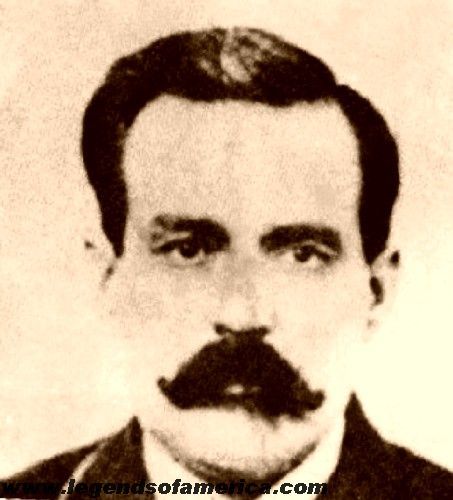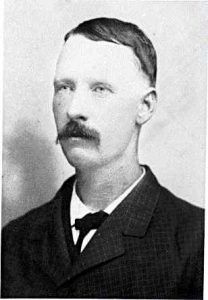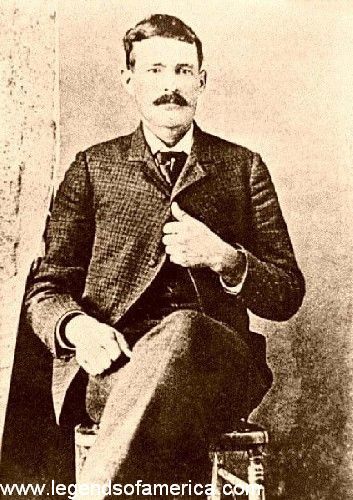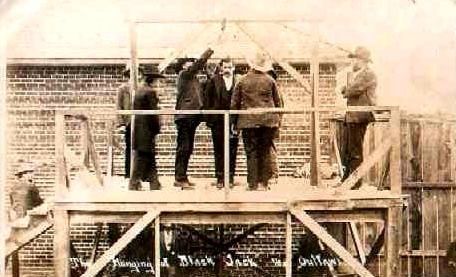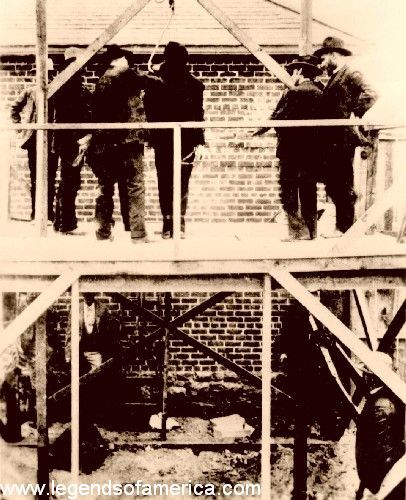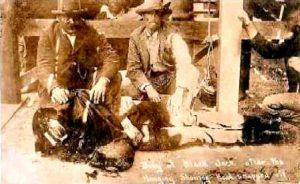Warning – Contains photos that may be offensive.
Thomas Edward “Black Jack” Ketchum was born on October 31, 1863, in San Saba County, Texas. His father, Green Berry Ketchum, Sr., died at 48 when Tom was only five. His mother, Temperance Katherine Wydick Ketchum, suffered from blindness before she died when Thomas was just ten. Both are buried at China Creek Cemetery in San Saba County, Texas. Thomas was the youngest of eight children — six boys and two girls.
Tom’s older brother, Green Berry Jr., became a wealthy and well-known cattle man and horse breeder. Another older brother, Samuel, married and had two children but left his wife when their son was only three.
Tom and Sam worked as cowboys on ranches throughout west Texas and northern and eastern New Mexico. On their many cattle drives, they quickly learned the territory and the settlers and ranchers in the area.
In 1892, Tom (Black Jack), his brother, Sam, and several other outlaws learned that an Atchison, Topeka & Santa Fe Railroad was en route to Deming, New Mexico, with a large payroll. The gang set up to rob the train just outside Nutt, New Mexico, a water station about 20 miles north of Deming.
The gang stopped the train, holding it up at gunpoint, and made off with about $20,000. During the robbery, the conductor had sneaked away, making his way to Nutt, where he telegraphed for help. Soon, a posse from Lake Valley, 18 miles to the north, was on its way. However, by the time the posse arrived, the gang was well hidden in their safe house, and Black Jack soon slipped into Arizona. The $20,000 was never found.
On December 12, 1895, Tom and several other men shot and killed John N. “Jap” Powers, a neighbor in Tom Green County, Texas. Tom later admitted to participating in the murder but claimed he was paid to do it. After this episode, Tom and Sam high-tailed it out of Texas back to New Mexico.
While in New Mexico, the Ketchum Gang was well known at many of the dances, social functions, and saloons in northeast New Mexico. These well-mannered young men, riding good horses, flashing plenty of money, and claiming to be cowboys, would arrive at the local functions where the women were enraptured by their manners. They were known to have frequented several establishments in Elizabethtown and Cimarron, specifically Lambert’s Inn, now the St. James Hotel. Not until later, when they were captured, did townspeople learn these young men were members of Black Jack Ketchum’s outlaw gang.
After leaving Texas in late 1895, the brothers worked at the Bell Ranch until sometime in early June 1896, when they quit, stealing supplies from the ranch before they left. On June 10, they showed up at the small settlement of Liberty, New Mexico, north of present-day Tucumcari.
During the night, they robbed a local store and post office operated by Levi and Morris Herstein. After the robbery, the Ketchum brothers rode hard to the Pecos River, with Levi Herstein and several other men chasing them. A gun battle ensued at the Pecos River, leaving most of the posse dead. The brothers then headed west to Arizona, where they sometimes rode with Butch Cassidy’s Wild Bunch.
Apparently, the Ketchum Gang felt confident in robbing trains between Folsom and Des Moines in this area of New Mexico. The area was where the old wagon road crossed the Colorado and Southern Rail tracks near Twin Mountain.
Their habit was to stop the train and uncouple the mail and express cars, which were then taken about a mile and a half down the track and looted. On September 3, 1897, Black Jack and his gang were back at it, robbing another train, making off with about $20,000 in gold and $40,000 in silver. They escaped after the robbery, hiding in a cave south of Folsom, New Mexico, where they remained until the next day.
On July 11, 1899, the gang struck again, this time without the help of Black Jack. After camping at the head of Dry Canyon in northeast New Mexico, Sam Ketchum, Bill Carver, and Elza Lay, aka William McGinnis, made off with some $50,000 from the train in Folsom, New Mexico. A posse soon pursued them to a hideout near Cimarron, New Mexico. The outlaws were better armed with high-powered rifles and smokeless powder, while the posse had conventional black powder guns, the smoke of which gave away their positions.
Sam Ketchum and McGinnis were both wounded in the gun battle and captured. The posse faired even worse, with two members, including Sheriff Edward Farr, killed and another posse man injured. Sam was taken into custody but developed gangrene from his wound. On July 24, 1899, he died in the Santa Fe penitentiary and was buried in the Odd Fellows Cemetery.
On August 16, Elza Lay was arrested and was later tried and convicted for the murder of Ed Farr and sentenced to life in prison. Carver escaped to ride with the Wild Bunch.
In the meantime, Thomas “Black Jack” Ketchum, unaware of the fate of his brother, Sam, made a final solitary attempt at train robbery on August 16, 1899. Waiting in a cave south of Folsom until after dark, he rode to where he intended to rob the train. Boarding the train from the blind side of the baggage car, he planned to force the train to stop, where he could disconnect the mail and express cars from the rest of the train.
But, Black Jack’s best-laid plans were doomed to fail eventually. He crawled into the engine and drew his pistol on the engineer and fireman, forcing them to stop the train. However, he had miscalculated the stopping point on a curve, leaving the train in a cramped position where it was impossible to uncouple the cars.
Conductor Frank Harrington, whose train was being held up for the third time, had finally had it. He took his shotgun to the baggage car and carefully opened the door, pointing the gun at Black Jack. However, Tom was too quick for him and shot at the conductor, just barely missing Harrington. Harrington also shot about the same time, hitting Black Jack in the right elbow, almost severing the arm. Tom fell backward out of the train and down the bank. Harrington ordered the engineer and fireman to move the train as fast as possible.
Resuming the run, the train stopped at each station, reporting the would-be robbery and sending word for law officers to look out for a badly wounded man near the hold-up scene.
Ketchum later reported, “I tried a dozen times to mount my horse but was too weak to do it.” Weary and dizzy from the pain, he sat down to wait for the posse. Early the next morning, as the sun rose, a freight train heading from Folsom passed the robbery scene. A man was seen about 100 yards from the train, waving his hat on the end of his gun as a signal. When the train was stopped, and the conductor and brakeman approached, Black Jack drew a gun on them. The conductor said, “We just came to help you, but if this is the way you feel, we will go and leave you.” Black Jack responded, “No boys, I am all done; take me in.” (In other accounts, Sheriff Saturinino Pinard is credited with the arrest). Black Jack was carried to the train, placed in the caboose, and taken into Folsom.
At first, Black Jack stated that his name was George Stevens and that the would-be robbery was his first attempt at a hold-up and a mighty poor one. He was taken on the first passenger train to Trinidad, Colorado, and placed in San Rafael Hospital, where his arm was amputated. When he could travel, he was taken to Santa Fe for safekeeping. Later, he was transferred to Clayton, New Mexico, for trial, where he pleaded innocent, but the judge found him guilty and sentenced him to death by hanging.
The hanging was delayed several times until lawmen heard rumors that the old gang would attempt to free Tom. Therefore, a decision was finally made, and the hanging was scheduled for April 26, 1901, at 8:00 a.m. The hanging was a big attraction, with stores closing and saloons remaining open, doing a brisk business. People came from all over the area to see the big event, where the local lawmen were selling tickets to view the hanging and little dolls of Tom hanging on a stick.
However, the town of Clayton had no experience hanging a man, and there was a debate concerning the length of the rope. The night before the scheduled hanging, the rope was tested by attaching a 200-pound sandbag to the noose and dropping it through the trap. Finally, at 1:13 p.m. Thomas “Black Jack” Ketchum was taken to the scaffold. While adjusting the hood, Ketchum stated, “Hurry up, boys, get this over with.” Finally, Sheriff Garcia took two blows with a hatchet, cutting the rope, and Tom fell through the trap.
Unfortunately, the inexperienced hangmen had forgotten about the sandbag they had used to test the rope, and its weight caused the rope to be as rigid as wire. When Black Jack fell through the drop, he was immediately decapitated. The black hood pinned to his shirt was the only thing that kept his head from rolling away. A few minutes later, the doctor pronounced him dead, then sewed his head to his torso before the burial at Clayton’s Boothill at 2:30 P.M. In the 1930s, his body was moved to the new cemetery in Clayton, where it remains today.
Black Jack Ketchum was the only person ever hanged in Union County, New Mexico. He was also the only person who suffered capital punishment for the offense of “felonious assault upon a railway train” in the State of New Mexico. Later, the law was found unconstitutional, but way too late for Thomas Ketchum. According to the annals of American Jurisprudence at the time, he was the only criminal decapitated during a judicial hanging in the U.S. The only other recorded example was in England in 1601. Later, the same thing occurred at the hanging of one Eva Dugan at the Pinal County, Arizona prison in 1930.
© Kathy Alexander/Legends of America, updated February 2023.
Also See:
Black Jack Ketchum Lives On – A Ghost Story
Ghost Stories From The Old West

